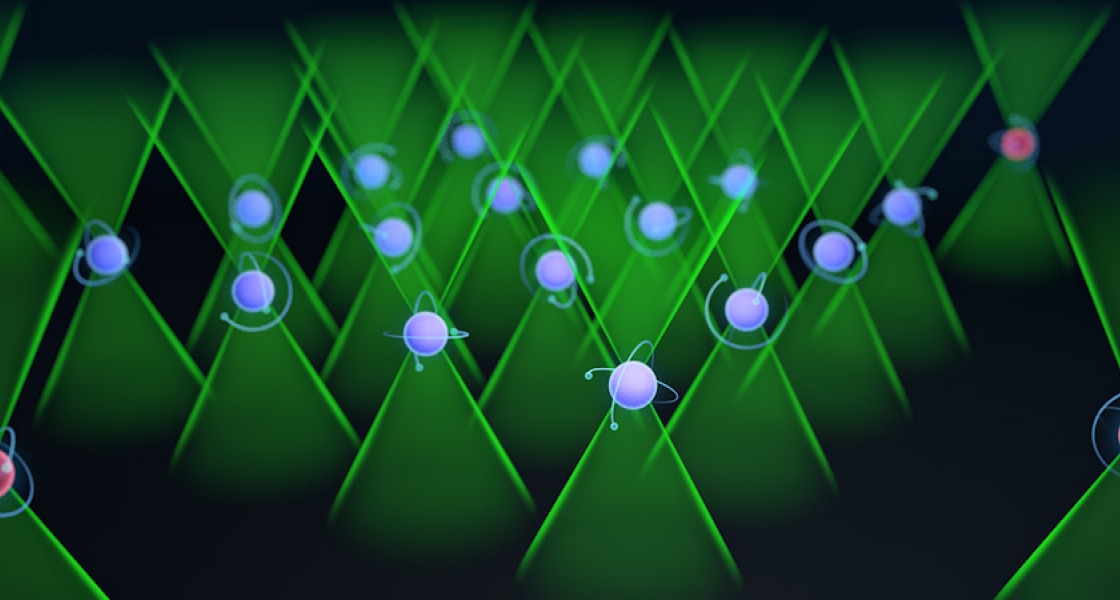As noted in their recent publication, JILA researchers have, for the first time, trapped a single alkaline-earth atom and cooled it to its ground state. To trap this atom, researchers used an optical tweezer, which is a laser focused to a pinpoint that can hold, move and manipulate atoms. The full motional and electronic control wielded by this tool enables microscopically precise studies of the limiting factors in many of today’s forefront physics experiments, especially quantum information science and metrology.
Previous to this work, the only singly trapped atoms descended from the alkali family. Alkalis are defined by their single outer electron, the simplicity of which makes their interactions with lasers easy to predict. Single–outer-electron atoms are therefore some of the easiest atoms to trap and cool.
But according to Aaron Young, a JILA graduate student on this experiment, the dual outer electrons are what make alkaline-earths interesting.
“Having these two valence electrons means that there is more richness and complexity in the electronic states,” said Young. “It means that there are a broader range transitions.”
Two Electrons—a Blessing and a Curse
Indeed, within the Strontium structure there are a plethora of optical transition widths. This variety is key for conducting complex experiments where cooling, imaging, and precision spectroscopy are needed from the same atom. Strontium has before been noted for its superb transition selection, which earned strontium its position in the world’s most precise atomic clock.
This variety of transitions allows researchers to work around some of strontium’s more difficult transitions. For example, unlike most alkalis, Strontium’s best imaging transition also causes significant heating. According to Young, the heating induced while imaging is enough to push an atom of its trap. But untrapping can be avoided by toggling a cooling laser between blasts of the imaging laser.
“By chopping these two [lasers] together, you end up being able to keep your atoms cool but also collect a large signal [in your image],” said Young.
In the end, the researchers can cool and detect single Strontium atoms with extremely high fidelity. This ability could prove crucial for studying many-body phenomena among complex, dual-electron atoms.
Adam Kaufman, JILA Associate Fellow and principal investigator of this experiment, credits much of this ability to a robust workaround that he calls “magic-trapping” conditions. In response to optical tweezers perturbing—or in other words, distorting—the strontium atoms to such a degree that they can no longer be trapped and cooled, the team developed an unperturbable strontium state by tuning the angle between the tweezer’s electric field and the experiment’s overall magnetic field. The technique proved to be especially effective, said Kaufman, and reduced the overall distortion to a part in a thousand.
Small Spaces, Big Possibilities
According to Kaufman, this optical tweezer can confine and image strontium atoms to within 480 nanometers—or less than a one three-thousandths the size of pinhead. This size is about 30% smaller than all other optical tweezers, which are currently limited by the trapping transitions of alkali atoms. And size does count here: smaller tweezers can more accurately move atoms in and out of small spaces, like optical lattice sites.
While some proposed experiments can be done with only tweezers (for instance, with the 4 x 4 grid of optical tweezers demonstrated in their latest paper), Kaufman says he sees this tweezer moving quickly towards aiding optical lattice experiments.
“That kind of capability—being able to rearrange atoms in a lattice potential—has never been done before. And the fact that our tweezer is so small is completely critical to and enabling of that,” said Kaufman.
Given their ability to hold many atoms with stable trapping forces, optical lattices are the basis of some of the today’s forefront experiments. And optical tweezers, which allow researchers to quickly trap, untrap and drag around single atoms, could improve upon these experiments.
“When you load into a lattice with 50 percent filling, the distribution is sort of random. But for these experiments involving tunneling, you really care about deterministically preparing a single configuration over and over again. That’s the part the tweezers are really good for,” explained Young.
This rearrangement technique could allow strontium atoms to test a well-known quantum computation problem called “Boson sampling.” The experiment, first proposed for photons, demonstrates the power of quantum computation by creating a configuration that a quantum computer can easily solve, but a classical computer cannot.
“One of the perks of the bosonic isotope of strontium is that you are able to get very clean tunneling and interference. And so, what we have just described—preparing some configuration of strontium atoms and then letting them tunnel around—maps directly onto this boson sampling problem,” said Young.
The team currently traps the bosonic isotope of strontium. But in the future, they want to also trap the fermionic isotope, which has a large nuclear spin degree of freedom. Controlling nuclear degrees of freedom, in addition to the electronic and motional, would allow the creation of spin-orbital exchange gates, which are a vital step in developing a neutral atom quantum computer.
“You can use collisions between atoms in different electronic and nuclear states to entangle the atoms, and then separate them so that the entanglement can be propagated in space,” explained Young, “which is exactly what you want for a quantum computer.”
This research, conducted by JILA Postdoc Matthew A. Norcia, graduate student Aaron W. Young, and Fellow Adam M. Kaufman, was published in PRX in December 2018. The authors above acknowledge the help of Ben Johnston and Will Eckner.
Written by Catherine Klauss




